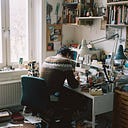How I Learned to Become a Failure
Before I was at Facebook, I worked in the wilderness as a freelance designer. During this time, I’d do all sorts of things to make life hard for myself. One of the worst was the “design magician” routine.
I’d land a client, have a few meetings, build up my own brief. Once I felt I had enough information, I’d disappear for a few weeks to go in search of rabbits from my hat.
“Leave it with me,” I’d say heroically. “I’ll be back soon with your solution.”
Now, this type of situation worked pretty well—most of the time. I’d pride myself on listening very carefully to what people wanted. Iterations were seldom and small, and clients were generally impressed with the concepts and how they’d miraculously come into being.
But looking back on it, this was no way to work. And when you mix this style of work with high-profile clients, trying to hit homeruns on a first swing is a recipe for disaster. It was also a sure-fire way to develop a creative block. The pressure I’d unnecessarily place on myself to produce a perfect solution inside my own little bubble was often crippling. Worst of all, it was probably avoidable, if only I’d established a different type of working relationship.
Big failures suck, small failures rule
What designers need more than anything is an environment where it’s safe to try things out. This happens when everyone accepts that things often need to be wrong before they can be right. Failure (and I use this term in the broad sense) is a necessary and valuable stage in the journey to a solution.
After all, there is a hidden success built into every failure. When you’re not emotionally attached to your work, ideas that aren’t quite right shouldn’t upset you—they’re simply feedback on the path to imminent success. So when we fail early and often, we learn faster, we understand the “game” of what we’re doing, and we adapt.
“But failing feels bad!” I hear you say.
I get it. We’re wired to avoid mistakes. Failing is the sort of thing people tend to do when they have no idea what they’re doing. But if you suspend that reaction for a moment, you’d see this beginner’s mindset is exactly where you need to be. It’s the very mode that has allowed kindergarten children to consistently outperform adults in problem-solving exercises.
You too can be a failure
“People always ask, ‘What is your greatest failure?’ I always have the same answer – We’re working on it right now, it’s gonna be awesome!”
—Jim Coudal
At Facebook, failure is openly encouraged. Posters adorn the walls telling us to “FAIL HARDER.” Of course, this type of propaganda isn’t entirely literal. It’s a signpost that’s pointing to something—a mental hack to help sidestep the real danger, which isn’t failure, but rather a fear of it. This mindset, coupled with a culture of openness, keeps our design team comfortable sharing ideas before they’re fully baked.
In a freelance design setting, the whole money-for-services dynamic makes it trickier to foster a relationship that is open to early failure. Firstly, you need to make sure your client understands you’re not simply there to impress them all the time. Sometimes giving up the magician routine is tough. But being a good designer isn’t about having all the answers—especially not right away. Unless you’re really good, that’s called being a hack. Being a good designer means having a spirit of exploration and being OK with the reality that things may not always end up how you planned.
To give yourself more space to fail, try breaking down your process into smaller steps that happen more often. This takes the risk out of design exploration. Instead of having a meeting, then delivering three rounds of polished concepts, try a few stages of prototyping before fully planning things out. The key is you get your hands dirty, fast, and iterate often.
When it’s time to deliver some concepts, send some first takes as soon as you can. Preface them with an explanation that they’re “directional” (because they are). While the client may be surprised they’re seeing anything at this stage, feedback on this early work is often twice as valuable as the original brief ever was. And if you’re like me, you’ll find these early concepts come easier because they don't carry the weight of expectation that “final” or even “first-round” concepts do. So hang up the top hat and cape. After all, you’re just a simple designer.
Happy fails.

